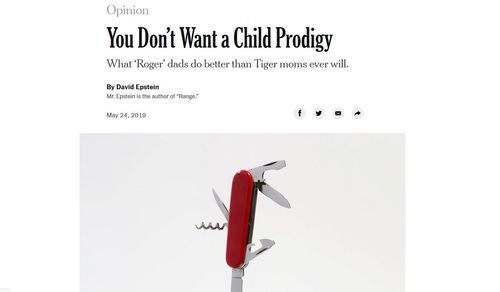


05/24/2019
David Epstein, who wrote the HBD-aware book The Sports Gene, has a new take on an old topic of discussion here at iSteve. From the NYT:
You Don’t Want a Child Prodigy
What ‘Roger’ dads do better than Tiger moms ever will.
By David Epstein
David Epstein is the author of the forthcoming “Range: Why Generalists Triumph in a Specialized World,” from which this essay is adapted.May 24, 2019
… I do find the Tiger Woods story incredibly compelling; there is a reason it may be the most famous tale of development ever. …
I entitled my book review last year in Taki’s Magazine of the Tiger Woods’ bio: “The Tiger Mother’s Son.”
And yet, I knew that his path was not the only way to the top.
Consider Roger Federer. Just a year before Woods won this most recent Masters, Federer, at 36, became the oldest tennis player ever to be ranked No. 1 in the world.
Tiger’s 15 major championships trail not only Jack Nicklaus’ 18, but also Federer’s 20.
But as a child, Federer was not solely focused on tennis. He dabbled in skiing, wrestling, swimming, skateboarding and squash. He played basketball, handball, tennis, table tennis and soccer (and badminton over his neighbor’s fence). Federer later credited the variety of sports with developing his athleticism and coordination.
While Tiger’s story is much better known, when sports scientists study top athletes, they find that the Roger pattern is the standard. Athletes who go on to become elite usually have a “sampling period.” They try a variety of sports, gain a breadth of general skills, learn about their own abilities and proclivities, and delay specializing until later than their peers who plateau at lower levels. The way to develop the best 20-year-old athlete, it turns out, is not the same as the way to make the best 10-year-old athlete.
The same general pattern tends to hold true for music, another domain where the annals of young prodigies are filled with tales of eight hours of violin, and only violin, a day. …
I found the Roger pattern — not the Tiger (or Tiger Mother) pattern — in most domains I examined. Professional breadth paid off, from the creation of comic books (a creator’s years of experience did not predict performance, but the number of different genres the creator had worked in did) to technological innovation (the most successful inventors were those who had worked in a large number of the federal Patent and Trademark Office’s different technological classifications).